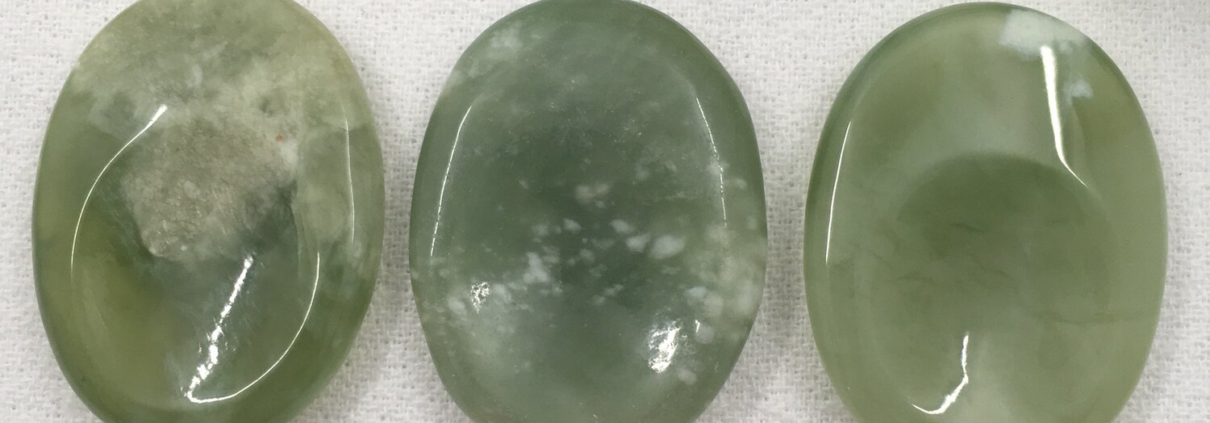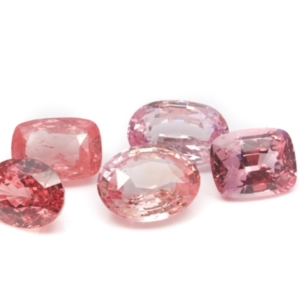Australian Jade (Bowenite)
Australian Jade, or more specifically Bowenite, is the type of serpentine valued for its aesthetic qualities and often used in jewelry and ornamental carvings. In essence, it is an antigorite mineral of the serpentine group. This mineral group is distinguished by a structure of sheet silicates, which imparts to Bowenite its fine, compact texture and greasy or waxy luster.
 Bowenite/New Jade Thumbstone – Dark Green (sueweaver.co.uk)
Bowenite/New Jade Thumbstone – Dark Green (sueweaver.co.uk)
The color of Bowenite can range from light green to deep blue-green and less commonly be yellowish-green or blue. It is somewhat softer than genuine jade but is valued for its translucence and beautiful range of colors.
Origins of the Name “Bowenite”
The 19th-century Governor of New Zealand, George Bowen, is credited with naming the stone “Bowenite” after the areas where it was first discovered and identified. Other occurrences include Australia. It is not only treasured in these countries but also is very important in Maori traditions in New Zealand, where it is used for carving tools, weapons, and ornaments, thus putting great historical and cultural value beyond just its geological characteristics.
Contents
- Physical and Chemical Properties of Bowenite
- Geological Formation of Bowenite
- Applications and Uses of Bowenite
Physical and Chemical Properties of Bowenite

Bowenite is a complex, unusual, finely-grained material of excellent luster. It also has high popular value in being a gemstone and for carving. The serpentine mineral group is unique in its own right, although sharing with other minerals the general characteristics that define a gemstone, including the following:
Chemical Composition
- Formula: The chemical formula of Bowenite is essentially that of antigorite, Mg₃Si₂O₅.
- Chemical composition: It primarily comprises magnesium, silicon, oxygen, and hydrogen. The structure allows plenty of room for slight variabilities where iron and several trace elements can replace magnesia thus, provide the color and density variety.
Physical Properties
- Hardness: Bowenite does not consist of a tough mineral, measuring a Mohs hardness of about 4 to 6. It is softer than many gemstones, including quartz and diamond, but is still challenging enough for use in various applications relating to artistic and jewelry works.
- Density: It always has a specific density within the range of 2.5 to 2.6 g/cm³, which comparatively is low regarding other more crystalline minerals.
- Lustre: Waxing to greasy luster, in polished section looking quite attractive.
- Transparency: Bowenite is either opaque or transparent, and the more transparent forms are widely used in various decorations.
- Colour: varies from pale green to blue-green, occasionally yellowish or bluish, often mottled or veined by impurities.
Structural Properties
- Crystal System: In the monoclinic crystal system, serpentine minerals do exist, but they are more common in massive form rather than well-formed crystal form.
- Cleavage: There is basal cleavage in one direction, so it can split along flat planes and will be relatively easy to carve.
- Fracture: Bowenite usually fractures in conchoidal or splintery shapes, two typical ways for most minerals with some degree of brittleness.
- Optical Properties: The relatively low index of refraction in Bowenite imparts a waxy luster and relatively weak shine when polished.
These properties make Bowenite a versatile material which is amenable to a wide range of decorative and practical applications. For example, jewelry, small sculptures, and various ornamental items are made from it. Its aesthetic quality is significantly promoted by its physical characteristics, in particular its luster and variety of color, and that is why it has found such wide application among handicraftsmen and collectors.
Geological Formation of Bowenite

Geological Environment Where Bowenite Forms
Bowenite, like other serpentine minerals, primarily forms through the metamorphism or alteration of ultramafic rocks. These rocks, originating deep within the Earth’s mantle, undergo changes due to the intrusion of hot, chemically active fluids or through the pressure and temperature changes associated with tectonic processes. This alteration process transforms the original magnesium-rich silicates (like olivine and pyroxene) into serpentine minerals.
The specific conditions conducive to forming Bowenite typically involve relatively low temperatures and high pressures, characteristic of the metamorphic environments found in subduction zones or areas where oceanic crust is forced into the mantle. The hydration process involved in these settings plays a crucial role in the conversion of the ultramafic rocks into serpentine.

Locations Where Bowenite is Commonly Found, Focusing on Australia
Bowenite deposits are found in several parts of the world, including New Zealand, China, Afghanistan, and the United States. In Australia, Bowenite is less commonly reported compared to other serpentine minerals, but it can still be found in specific localities known for their geological diversity and richness in minerals.
- South Australia: Known locations include areas where serpentine rocks are prevalent, providing the right conditions for Bowenite formation.
- Western Australia: Some regions with complex geological histories involving ultramafic rocks might also host Bowenite, although such occurrences are relatively rare and less well-documented.
Comparison with Other Serpentine Minerals
Bowenite is part of the serpentine group, which also includes minerals like antigorite, lizardite, and chrysotile. Each of these minerals shares a basic chemical composition and similar formation processes but differs in crystal structure and physical properties:
- Antigorite: Often found in more fibrous forms and is the predominant form of serpentine in many serpentinite rocks. It tends to form at slightly higher temperatures than Bowenite and has a hardness similar to Bowenite.
- Lizardite: The most common type of serpentine, characterized by its microcrystalline, leafy aggregates that form at lower temperatures. It is generally softer and less suitable for carving than Bowenite.
- Chrysotile: Known as asbestos, this fibrous variety is the most flexible of serpentine minerals and forms under similar conditions as other serpentines. It has significant industrial uses but also poses health risks.
Bowenite is distinguished from these minerals by its greater suitability for ornamental carving due to its hardness and the fine quality of its finish when polished. It also typically exhibits a range of green colors that are particularly valued in decorative stones. These characteristics, along with its geological rarity, make Bowenite a unique and valued member of the serpentine mineral group.
Applications and Uses of Bowenite
 Bowenite/New Jade Chunky Bracelet (sueweaver.co.uk)
Bowenite/New Jade Chunky Bracelet (sueweaver.co.uk)
Considering its unique physical properties and aesthetic value, Bowenite is found to serve several applications and uses in industries and cultures around the globe. Some significant applications and uses of Bowenite are as follows:
Jewelry and Decorative Use
- Jewelry: For necklaces, earrings, and bracelets, most Bowenite carvings usually come in forms such as pendants, beads, and cabochons. Its translucency and range of green tones make it a good substitute for jewelers who want a less costly replacement for jade in their designs.
- Carvings: This stone is especially preferred for delicate carvings to create figurines, sculptures, and many more decorative pieces. The ability of the material to take a fine polish further enhances the detail and depth of such carvings.
Artistic and Cultural Value
- Cultural Artifacts: As in New Zealand, so is the use of Bowenite mineral that it has become a culturally traditional tool for Maori that turns it into various instruments – tools, weapons, and perhaps even ceremonial items like “hei-tiki” and “mere”: short broad-bladed weapons. These highly valued implements are considered taonga within Maori culture.
- Decorative Objects: Bowenite is the favorite of artisans from around the world for making items of decoration, like bowls, vases, and inlays in furniture or other expensive décor items, because of its beautiful color and finish.
Industrial and Practical Uses
- Architectural Features: At a smaller scale, owing to both durability and good looks, Bowenite can be used as tiles, countertops, and facing stones in architectural elements, especially in installations that require a touch of natural beauty and class.
- Technical Applications: The physical properties of Bowenite, such as heat and resistance to some chemicals, would render it applicable to some select technical applications in which other more common minerals would not be well-suited.
Healing and Metaphysical Properties
- Crystal Healing: At times, Bowenite may find its way to crystal healing. It is believed to promote emotional balance and stability and assist in the process of detoxification within the body. These metaphysical properties, never scientifically proven, make Bowenite the favorite of alternative wellness and holistic health communities.
The adaptability of Bowenite, with its unique properties, has kept it material in demand—from practical appliances to artistic creations. Its use spreads widely in application areas, from fine art and cultural artifacts to more contemporary use in jewelry and decorative arts.


Leave a Reply
Want to join the discussion?Feel free to contribute!